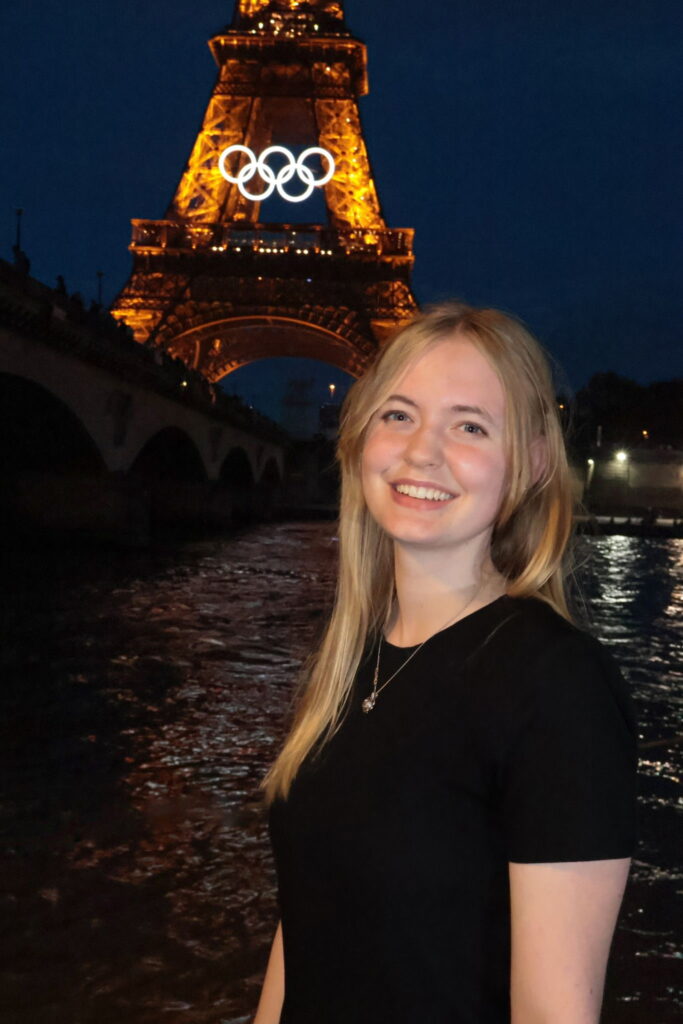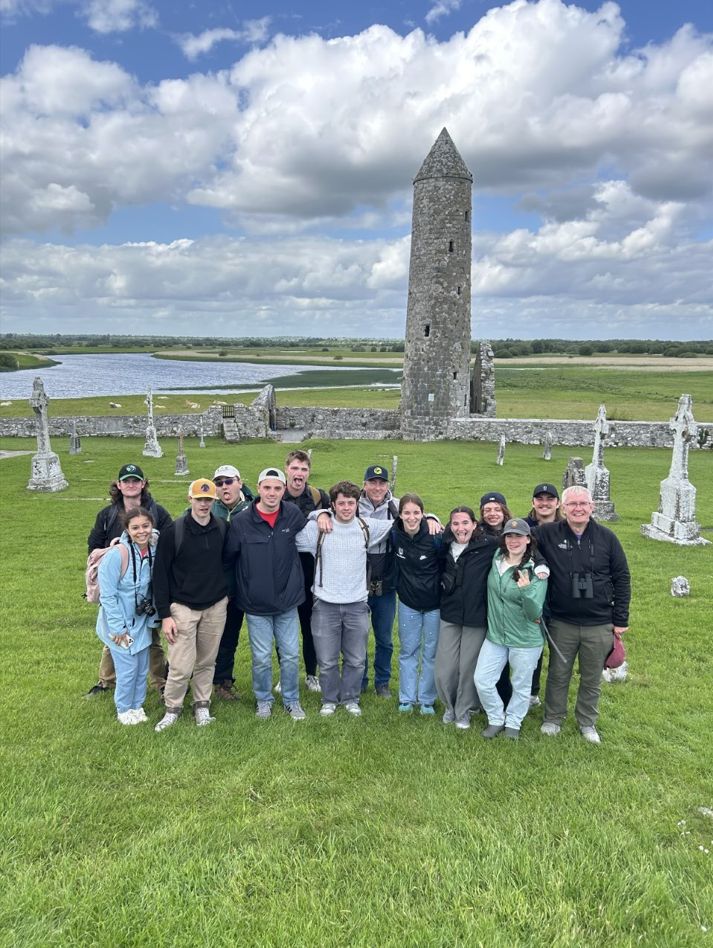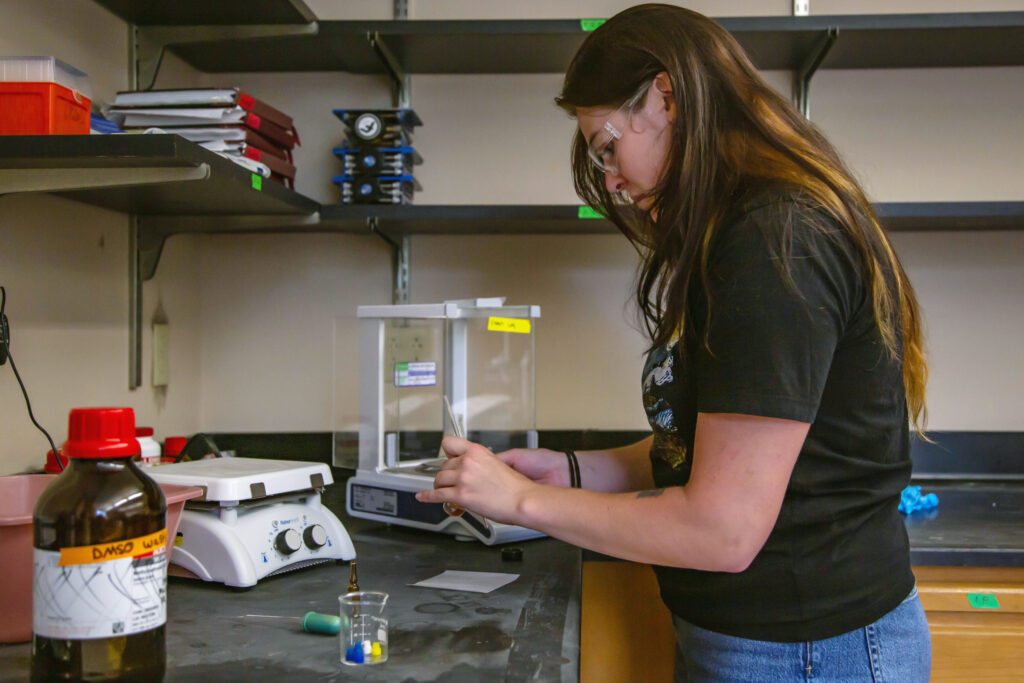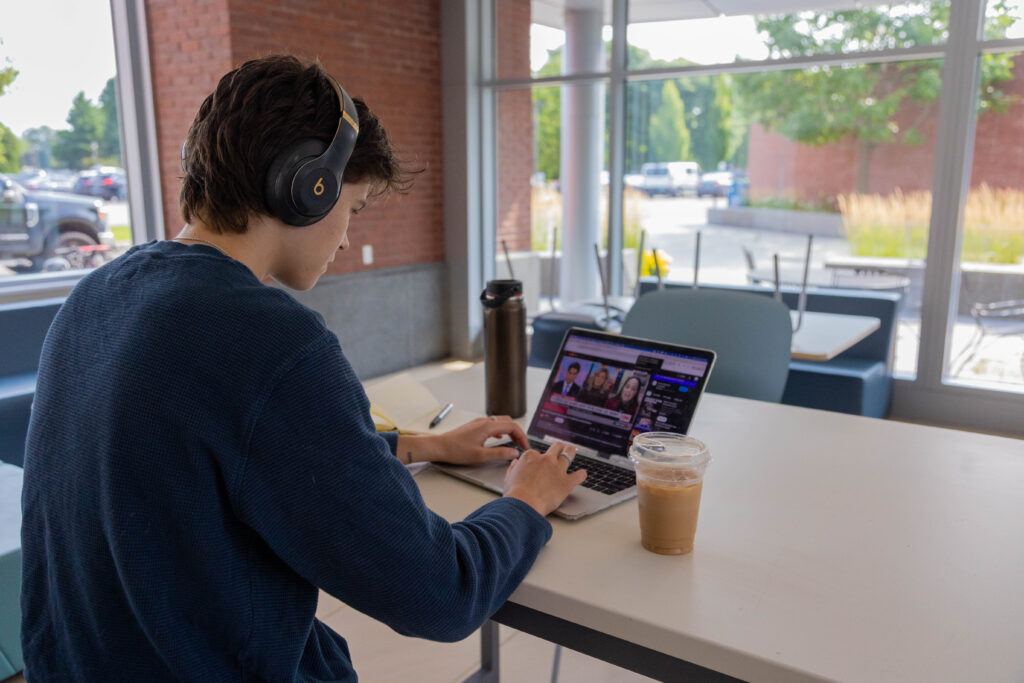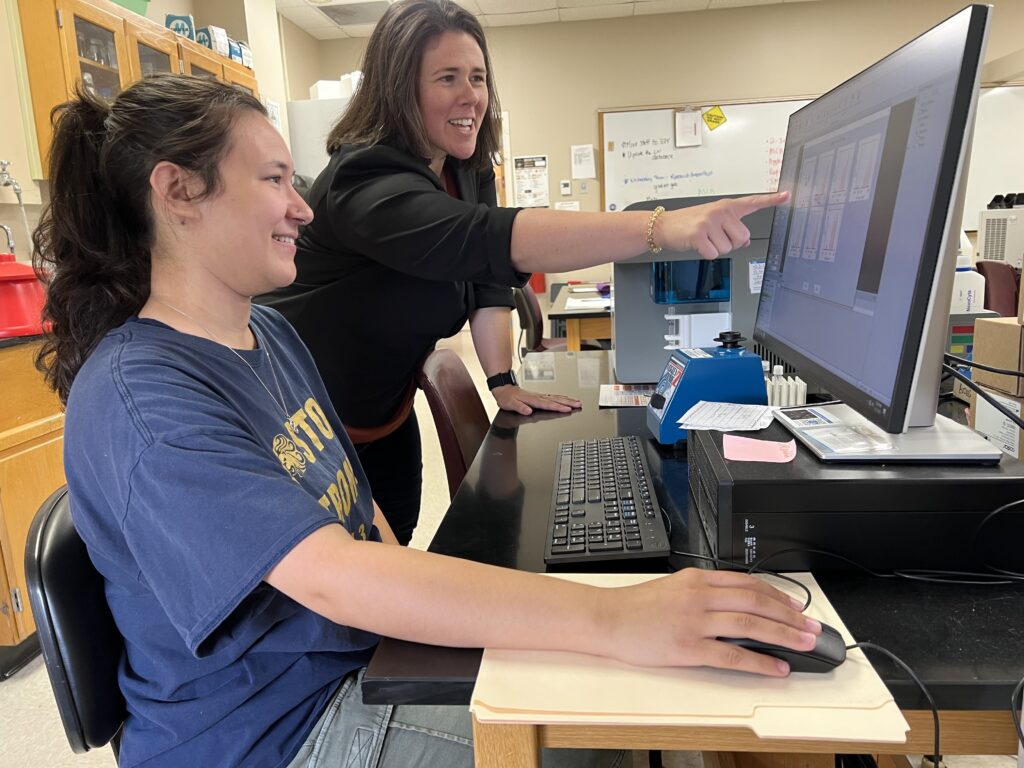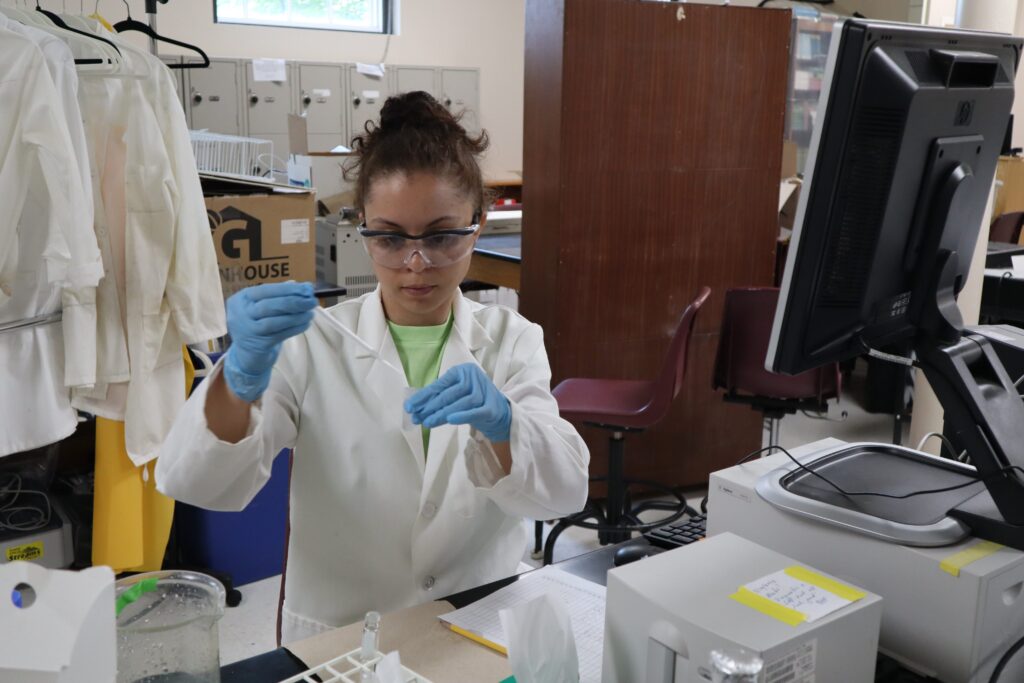Student summer research trio strives to advance diabetes therapy in Dieni lab
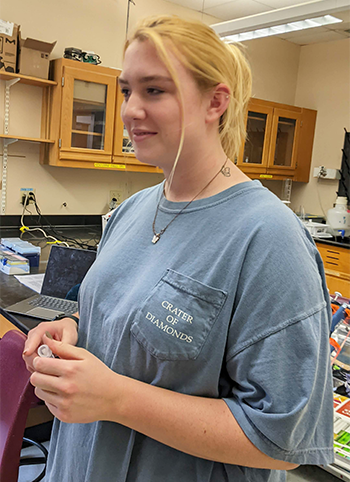
Jamie Hearn ’26 in the Cheray lab where she is doing summer research on diabetes. The large image behind the headline shows her fellow students, Jack Macdonald, left, and Jack Conroy, doing tests using some of Cheray’s equipment.
A Saint Michael’s College Fire and Rescue call on the Monday overnight shift in mid-June was to help a diabetic patient experiencing low sugar levels or hypoglycemia. One student responder on the crew, Jamie Hearn ’26, brought even greater than usual expertise and personal investment to the call.
“I personally have a long history of Type 2 diabetes in my family,” Hearn said a few days later as she tended to lab tests on the second floor of Saint Michael’s Cheray Science Hall where Professor Christopher Dieni and his students are advancing therapeutic approaches that might help diabetics significantly in the long-term.
Having recently lost her grandfather to diabetic complications, Hearn feels the importance of her College-funded summer research work, given also that her dad struggles with symptoms of the condition too. A rising sophomore from Charlotte, NC, the biochemistry major with a minor in art history was working this morning alongside two older male fellow summer research students, Jack Macdonald ’25 and Jack Conroy ’24.
Macdonald is a biochemistry major from Baraboo, WI, with minors in chemistry and neuroscience and a career interest in psychopharmacology, while Conroy, an aspiring medical school student from Dorchester, MA, is a biology major with a chemistry minor. Like Hearn, he serves on the Saint Michael’s Rescue squad.
Mentoring all of them has been Professor Dieni, a friendly, energetic and clear-spoken biochemist from Canada nearing the end of his first year on the St. Mike’s faculty while he pursues an abiding research focus on insulin resistance and sensitivity. Dieni said that he, too, became interested in the field because of the diabetes that has affected several generations of his family.
“Particularly on my paternal grandmother’s side, that whole branch was wracked with diabetes and metabolic complications,” he said, adding that even a paternal grandfather was afflicted with diabetes though later in life. “It hit my grandmother pretty hard and she ended up having both her legs amputated as a result of stroke and gangrene and all those complications that arise in diabetes so it’s been a part of my history for a long time.”
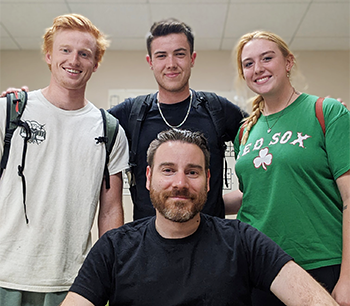
Professor Christopher Dieni, seated, and his summer lab team, from left, Jack Macdonald, Jack Conroy, Jamie Hearn.
Beyond that powerful family motivator for pursuing his research, Dieni said, “It’s just very fascinating metabolic disease that takes pieces from essentially everything from metabolism to immunology, inflammation, cellular biology, anatomy and physiology, since it’s not just one cell type in one organ that’s affected,” as with some disease-research fields.
The three summer students in his lab are working on different aspects of research into insulin resistance: Hearn will examine ways to create an early detection test for insulin resistance that is affordable, reliable and minimally invasive. Early diagnostics have strong potential to help patients adapt to life with diseases caused by insulin resistance – or in best cases, undergo preventative management to lessen the severity of the disease or avoid it altogether.
Macdonald and Conroy will look at the interventional side of insulin resistance – specifically, novel insulin sensitizers and other therapeutic measures used to reverse insulin resistance. They will focus on the “capsaicin receptor” – the name relates to the hot ingredient in chili peppers – to determine what, if any, therapeutic potential this receptor has in reversing insulin resistance.
Dieni displays the teaching researcher’s gift for explaining his complex field in terms understandable even to non-scientists. The notion of seeking medicinal value from plants – in this case, hot chili peppers — is nearly as old as science itself, he said, explaining how an ancient practice of boiling willow bark and using the acid to bring pain relief developed into aspirin less than 200 years ago.
“It’s usually the way things work,” he said. “We try to find a compound in nature that naturally already exists and can have medicinal properties, find out what features of that compound are necessary for its effects, and then go into the lab and try to modify it to make that into a drug with fewer side effects that is longer-lasting, more readily available. It’s really an amazing process that, from start to finish, touches not just on metabolic biochemistry but lots of interdisciplinary areas of science.”

Figuring out the science on the lab white board, day by day.
“It’s a 50,000-piece jigsaw puzzle,” Dieni says of diabetes research, “so it you don’t like puzzles, you will probably beat your head against the wall.” Clearly, however, he and the students thrive on such puzzles.
Says med school hopeful Conroy, “It seemed a good opportunity to work with liver cells and insulin resistance, since Type 2 diabetes is a critical disease that’s prominent in the medical field. It’s a good thing to know a lot about.” He and the others were excited this day to get their hands on a fresh delivery of human liver cells stored on liquid nitrogen in cryovials that they will use in their lab investigations. “Yesterday we thawed them out, gave them nutrients in flasks to grow so they can proliferate over the weekend,” said Dieni, adding that waiting for cells to grow can be “like waiting for a cake to bake.”
Aspiring pharmacologist Macdonald sees “a lot of parallels between where I want to end up and what Professor Dieni is doing now … so I think it’s going to be a huge thing for me in psychopharmacology, especially in neuroscience, just getting the ground work on a lot of lab experiences.” He adds, “Enzyme activity is interesting to me and I think will help me a lot in what I want to study.”

Jamie Hearn prepares plates ….
Dieni has broad first-hand points of reference in appreciating the great value for students of doing such science research at a smaller liberal arts college like Saint Michael’s versus at larger research universities. The professor earned his bachelor’s in biochemistry from Concordia University in Montreal, worked for a time in the start-up biotech industry in Montreal, and has both taught at primarily undergraduate institutions and served at research universities, earning recognition with several teaching awards. His stops in academia, chronologically, have been: Mount Allison University (New Brunswick, Canada, 2012-2014), Carleton University in Ottawa, Ontario where he earned his doctorate (2014-2016), then brief successive stints teaching and/or doing research at Algonquin College, Ursinus College, University of Windsor in Canada, Colorado Mesa University and most recently Spring Hill College in Alabama. The playful acronym for his lab is “LEoPARD: Laboratory for Evaluation of Pharmacological Agents in Remediation of Disease.”
Alongside the direct science, his students learn how important it is for researchers to be able to seek and obtain funding for their work. Two of the summer student researchers work thanks to grants from the College’s Academic Affairs Office, while Conroy is funded through the Vermont Biomedical Research Network (VBRN). VBRN is an important partnership for his research, Dieni said, not only for the critical funding it provides, but also for indispensable resources such as the discounted or free ability to use higher-level and costly infrastructure that the University of Vermont can offer as a larger research university.
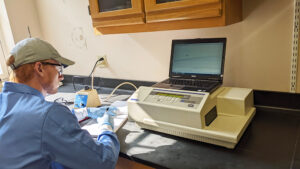
…and Jack Macdonald mans the plate reader equipment.
The VBRN, formerly the Vermont Genetics Network (VGN), is in its fourth phase of funding with a five-year $19.4 million award from the IDeA Networks of Biomedical Research Excellence (INBRE) program of the National Institute of General Medical Sciences (NIGMS) at the National Institutes of Health, its website states. The mission of VBRN is “to build human and physical infrastructure in Vermont for biomedical research. The lead institution, the University of Vermont (UVM), has developed state-of-the-art facilities for Proteomics and Bioinformatics as well as a Professional Development and Education Core to provide to researchers across Vermont the resources they need to carry out world class research and compete for federal funding.”
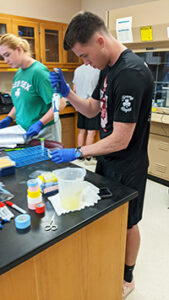
Often the lab demands teamwork.
Saint Michael’s research students commonly work over several of their college years, both summer and academic year opportunities, with ongoing projects like Dieni’s insulin resistance work. Just a rising sophomore, Hearn says she would be pleased to continue with it through graduation. Dieni has no doubt the work still will be going in three years and well beyond, since even elucidating one piece in the complex diabetics “jigsaw” puzzle and “fitting one piece against another” promises “there’s always another dimension and aspect” to explore.
In another example of distinct plusses for student researchers at smaller liberal arts colleges, Jack Macdonald is working on a manuscript related to his work on the project that might lead to a presentation at a scientific conference, for instance. “I threw him in the deep end because here there are no barriers,” says Dieni. “It’s a double-edged sword with the ‘pro’ being that they have all the responsibility, and the ‘con’ being they have all the responsibility!”
“That enhanced responsibility before they even have their bachelor’s degree means they can fairly easily outcompete undergraduate students who are little more than a number at larger universities where classes have hundreds or thousands of students,” Dieni said, “Here at St. Mike’s, they’re doing real, relevant, applicable work – authentic work.”

All three student summer researchers from Dieni’s lab had the chance to tell fellow summer research students at a June brunch with leaders from academic affairs about their hopes for their work. From left, Hearn, Macdonald, Conroy.
